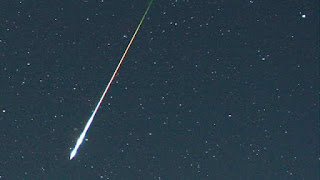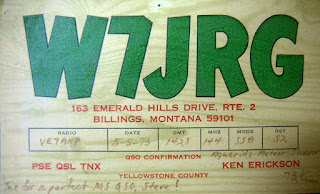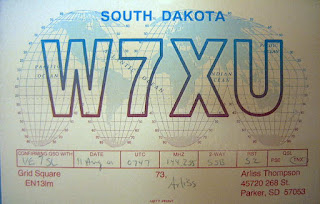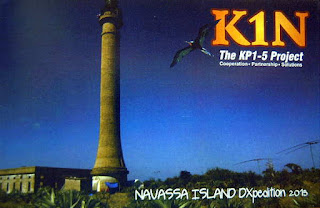Posts Tagged ‘2m’
 April’s Single-Yagi EME
April’s Single-Yagi EME
A website that helps determine when these good days occur, is the Making More Miles On VHF eme page. A graphical display of several important elements will easily determine which days might be best to operate ...
 |
| courtesy: http://www.mmmonvhf.de/eme.php |
This month saw six EME contacts, some with stations worked previously, in 2007, and not 'new uniques', while three were new, bringing my uniques total to 73, with this small, horizon-gain assisted system.
G4SXW John 4 x 16el array #71 ... answered my CQ
KB8RQ Gary 24 X 13el array!! worked with moon at 1 deg high
UX5UL Oleg 4 x 16el array #72
UT6UG Val 4 x 32el array #73 Val and Oleg both live in Kyiv, Ukraine
RK3FG Anatoly 4 X 15el array
K9MRI Joe 8 X 28el array - Indiana
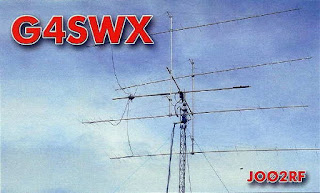 |
| G4SWX 4 x 16 el EME Array |
 |
| KB8RQ 24 x 13 el EME Array |
As summer approaches, it will be interesting to see how favorable the above mentioned variables will come into play as many of the best northerly declination days will also closely follow the sun and its increased background skynoise ... not so much a problem for me but for those bigger stations trying to hear a very weak signal in a noisier sky.
 March’s QRP EME Window
March’s QRP EME Window
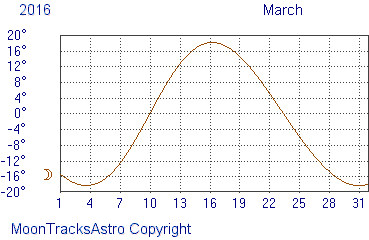 |
| Lunar declination track for March courtesy: http://www.moontracks.com/moon-declinations.html |
My minimal system (single 9el Yagi and 140w) makes it very easy to see the day to day changes in EME conditions due to various causes such as local geomagnetic conditions, Faraday rotation and libration fading ... or combinations of each! One of the days was particularly good, with numerous signals heard throughout the session while the next day was just the opposite, with only a few very weak signals and no contacts. On that particular day, I was being heard well by several European stations but was unable to hear any of them ... a true 'one-way' path and not uncommon on EME.
 |
| My small EME station. Note old microwave oven blower on the 'brick' amplifier. |
Several smaller 4-Yagi stations were worked during the week, re-enforcing the benefits of having a moonrise over the ocean. As mentioned previously, the extra 6db of horizon gain allows my single 9el Yagi to perform more like a stack of four 9el Yagis. One of the fellows that I worked, DK5EW in Germany, asked if there was anything 'special' about my location that would make my very small station sound so strong at his end ... the ocean is clearly doing its job!
Altogether, 12 new stations were worked during March's window, bringing my total to 70 "initials". From the looks of the amount of activity, there are still many stations yet to work, that should be within range of my system.
Stations worked this week were:
I2FAK, UA3PTW, RZ3BA/1, SK5AA, PA2CHR, ES3RF, YO3JR, PA5Y, DK5EW, SM7GVF, EA4CYQ and W5ZN.
Three of these stations were using relatively compact antenna systems, consisting of 4x8el or 4x9el arrays, while the rest were larger. I have yet to tally up my DXCC or states total on 2m, but I know that W5ZN, in Arkansas, was a new state.
Up until this past week, the highest moon elevation that I have completed a QSO was with the moon at 18 degrees above the horizon. This week it was extended, at what is probably the limit of my fixed antenna, to 19.6 degrees when working ES3RF. At the other end of the scale, IK2FAK was worked with the moon at only .87 degrees high!
This month also provided my first glimpse of a 2m DX 'pileup', when J8/WW2DX in the Grenadine Islands showed up, calling CQ via the moon. My screen shot below shows at least 12 different stations calling him during his one-minute listening period ... some not yet 'warmed-up' as seen by their drifting oscillators.With several of the signals audible, it was an amazing thing to observe.
 |
| 2m pile up on J8/WW2DX |
 |
| The 4 x 8 el cross-polarized array of PA5Y |
 |
| YO8JR sending his 'RR' followed by '73' |
 Single Yagi Moonbounce
Single Yagi Moonbounce
 |
| courtesy: JPL/NASA |
In early 2007, I decided to try 2m moonbounce using WSJT's JT65B digital mode. Over the years, moonbounce has gradually drifted away from CW to the much less demanding weak signal digital mode, allowing smaller stations to still explore the excitement of exchanging signals via reflection from the lunar surface. I am fortunate to have an excellent QTH for such an endeavour, being located beside the ocean with a saltwater horizon favoring moonrises, especially during the winter months of more northerly lunar declinations.
 |
| Moonrise from front yard |
I soon realized that the actual numbers appeared very close to predicted values and using an inexpensive 2m FM/SSB 'brick amplifier' (with built-in GasFet preamp) delivering approximately 140 watts, I was able to work 54 different stations over the next twelve months. All of the stations worked were doing the heavy lifting, with the majority running typical 4-yagi H-frame arrays using yagis from 6 to 17 elements each. I did work one station that was using two small yagis during a period of excellent conditions. Somewhat surprisingly, a large majority of the stations I worked were strong enough to be heard audibly from the transceiver's speaker.
I'm always amazed at the truly small amount of RF energy that is actually left, after the round trip to the moon ... yet information can still be exchanged. On 144MHz, the round trip losses are a minimum of 250db. Factoring-in my antenna's gain and ignoring the coaxial losses in 70' of RG213, there is a scant 1.56 x10^-9 W arriving at the moon ... that's .00000000156 W! Considering how much RF is absorbed in the lunar dirt and what's left over for the -125db home trip, it's a miracle that some signals are loud enough to be heard by ear at all. EME is really one of ham radio's most fascinating activities.
Reacquainting myself with the newer version of the JT65B software, and testing out the system, I was ready to go on the next evening's moonrise. Unfortunately the moon was rising just a little too far south to give me a really clear shot and I would be pointing into the next door neighbour's trees. Being unable to track the elevation, my operating time is limited to about two hours per session, over a period of several successive days (or nights).
Almost coincidental with the night's moonrise, I heard the strong signals of RX1AS (Alex) in St. Petersburg, calling CQ. I called him and he came right back with my signal report. His station is shown below, along with his large homebuilt strip-line amplifier.
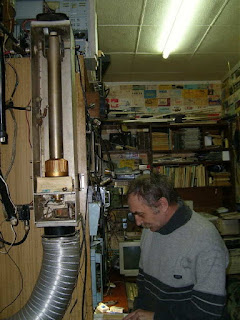 |
| RX1AS |
The following evening, the moon was buried even deeper into the trees but initials #56 and #57 were worked ... YL2GD (Gunars), in northern Latvia and RX3A (Nikolay), in Moscow city.
 |
| YL2GD and his EME station |
 |
| RX3A's 2m EME array |
Nikolay was worked with the moon at 11 degrees above the horizon. I'm not sure just what my upper limit for lunar elevation might be with this small antenna but the highest elevation I have worked anyone was at 18 degrees.
The third night found less activity on the band as well as a more southerly moonrise, burying my target even further into the neighbour's trees. Few signal were heard but one contact was easily completed with I3MEK (Mario), near Venice ... initial #58.
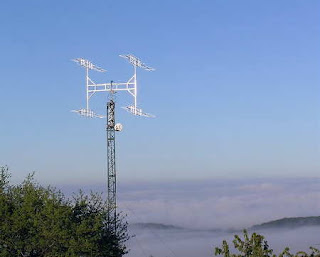 |
| I3MEK's 4-yagi 2m EME array |
 |
| I3MEK's 2m JT65b signal |
With so many larger (four or more yagis) stations around the world, a huge antenna is not needed to have success on 2m JT65B moonbounce ... nor is an over-the-ocean moonrise. I've also been able to work stations on moonset where I am pointing over hilly terrain and trees, nowhere near the ocean.
The WSJT (JT65B mode) software is freely available and very easy to implement, but spend some time reading the manual and playing with the software first, perhaps getting used to QSO procedures on 20m.
If you are running a small FM/SSB amplifier on 2m, such as the typical 'brick' I have been using, make sure to add a blower to keep the heatsink cool, as JT65 has a 100% duty cycle and these small amplifiers can get hot pretty fast. I use a small squirrel-cage blower from an old microwave oven to direct a blast of air onto the cooling fins.
Wondering where to point your antenna? One handy site that will provide the moon's position in the sky, for any time and any location, is the U.S. Naval Observatory's 'Sun or Moon Altitude/Azimuth Table'. As well, you can keep abreast of real-time activity or set up skeds, via NØUR's Ping Jockey JT65 EME page.
If you do decide to give this a shot, I'd be interested to hear how you do ... maybe your system is big enough already to let us work each other via the moon.
 2m big-wheel – 3dBd gain without rotating
2m big-wheel – 3dBd gain without rotating
Since its erection yesterday in its proper home by David G0LRD all seems to be working well.
A quick check this morning and I am able to copy the Kent, Dutch and Belgium beacons on 2m and GB3LEU (NW of Leicester) beacon on 70cm with the FT817 and 2m big-wheel. This is a single 2m big-wheel (not a stack) from Wimo in Germany.
It has 3dBd horizontal gain and is omni-directional. It is an ideal SSB/CW/data antenna for casual operators like me. “Real” operators would use it and a beam: the big-wheel to watch all 360 degrees and a big gainy beam to pounce in the choice direction. Being one who does not take the hobby too seriously just the big-wheel suits me and my style of operating! I did not look for other beacons. It is nice not having to worry about a beam and rotator.
I have still to try this antenna (and feeder) as an HF vertical via my ATU. It should work on at least some HF bands.
 Perseids Peaking
Perseids Peaking
Nowadays, using FSK441 WSJT software, a lot of good fun can be had most non-shower mornings on meteor scatter, just using random meteors. My experience when using the same software during an actual shower has been disappointing, as often the signals are too strong or too long for the software which is looking for shorter, weaker signals. During a large shower such as the Perseids, where typical burns can be quite lengthy, my own experience has given better results with good old SSB or fast CW.
I clearly recall my first-ever meteor scatter QSO, made during the May Aquarids, back in the early 70's. I had arranged a sked with Ken, W7JRG, in Montana. I had grown up reading about Ken's VHF exploits in both QST and CQ as a teenager and was excited about the possibility of finally possibly working him. My station was homebuilt, using a 6360 transverter driven from my Heath HW-100, and feeding a homebrew 5894 amplifier with 1/4" copper tube plate lines. The amplifier produced just a shade over 100W output. My antenna, also homebrew, was a 24-foot 13 element Yagi ... probably not the best for meteor scatter although it worked well enough for me to ragchew every night with stations in Portland, Oregon on SSB.
A few minutes before our sked, I decided to make one final check of my system. Our sked was to be on SSB, using 15 second sequences. I keyed down at full-power and did a final tweaking of plate tuning and antenna loading, and unkeyed, back to receive mode after about 30 seconds of tuning up. My receiver immediately sprung to life with a very loud SSB signal, slightly off-tune. Thinking it was my local buddy, VE7BLF, calling me before the sked, I was surprised to hear a different voice ... it was Ken in Montana at S9++ ..."I've been holding my breath waiting for you to unkey there Steve ... thought you would never finish!"
Needless to say I was just as surprised as he was. We talked back and forth for about another 60 seconds before the burn finally dissipated and signals were gone. What a great introduction to meteor scatter, with the QSO completed before the sked even started! Ken later told me that of all of the meteor contacts he had made, it was one of his best ... I guess we just hit it right.
Of all the showers, I always found that the December Geminids was the best, even better than the August Perseids, at least for the North-South path. Having said that, my longest meteor contact was made during the Perseids, with Arliss W7XU in South Dakota ... just a shade over 1300 miles while running just 40W SSB to a 9el Yagi.
Good luck if you are doing some meteor scatter tomorrow or even if you are just watching the shower visually ... conditions should be ideal, if the skies are clear, as the very new moon's sliver does not rise until near dawn.
 2m SSB history
2m SSB history
 |
| IC202 |
For me, 2m SSB began with the purchase of a 10W pep Belcom Liner 2, which opened up 2m SSB to the masses. Before then, people used homebrew transverters and HF rigs to get on VHF SSB.
After that I owned the IC202 from ICOM which had a very good VXO but less power (3W pep). Later, the first digital synthesised rigs appeared and 2m SSB really took off.
In the last 20 years or so, certainly here in the UK, VHF/UHF SSB took a nosedive and what little VHF/UHF activity there is is mainly using FM. Here in the UK there is good SSB activity in contests and in good lifts, but little casual use of the SSB/CW modes, which is a pity. Ranges on SSB can be much greater than FM for similar power levels.
When I first used my Liner 2 I was amazed how far I could reach in flat conditions, even with 10W and a small indoor antenna.
 A New Country and Some 2m Es
A New Country and Some 2m Es
The summer propagation doldrums, as well as my roof reshingling projects, received a short respite this week with the arrival of a new DXCC QSL for 160m. The K1N card (Navassa Island Expedition) was received for my CW QSO this past winter. The card brought my 160m DXCC total to 155 worked and confirmed while adding one more to my overall all-band total of 336 / 336.
Sunday afternoon brought a rare and welcome 2m sporadic-E opening. Signals on 6m towards Colorado quickly rose from a normal 'S9' to ear-shattering S9 + 30-40db with one signal putting the S-meter of my IC-756PROIII hard against the right pin and completely blanking the bandscope's lower regions ... I have only seen this happen once before, when beaming semi-local VE7XF while he is running high-power.
I immediately activated my Es MUF receiver (Icom R-7000), tuned to an empty FM frequency and squelched. Not long after, the squelch broke with a strong signal also from Colorado and several more throughout the band. It is difficult to ID FM signals as they rarely identify except at the top of the hour.
After several CQ's on 144.200 (9el yagi and 150 watts) aimed to the SE, W9RM in Colorado popped-up briefly with an S9 signal and was quickly worked before he faded. Unfortunately, either due to lack of activity or fast-deteriorating conditions, his was the only signal heard. In terms of 'quality' of the opening, it was poor, but any 2m Es is always exciting.
I once had a two-hour 2m Es opening to southern California and worked 32 Californians on 2m SSB before conditions faded ... it would be nice to see that once again. One of the fellows I worked that night had just set up his new 2m transceiver and, not being familiar with 2m propagation, told me 'I'll look for you again tomorrow night'. I told him that he could look for me for the next 20 years and he'd likely not hear me ... that opening was 32 years ago!
Let's hope we get some more 2m Es before the season ends as it is one of the most exciting propagation experiences there is.


